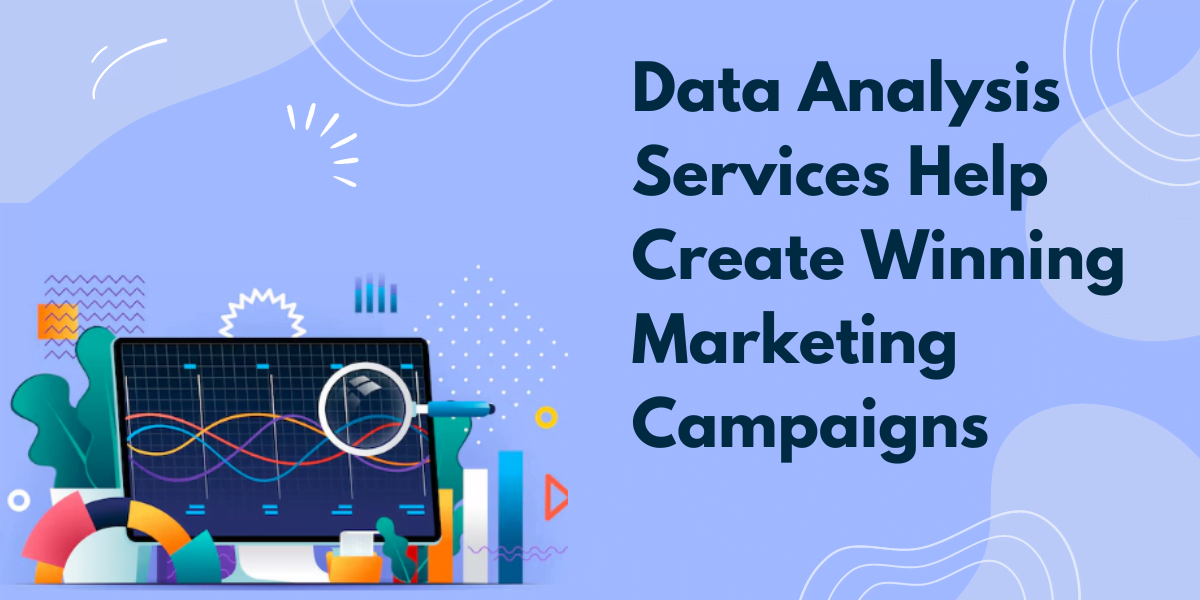There is no denying that today’s marketing strategies have undergone a drastic transformation from simply a creative domain to a real-time data-driven industry, harnessing quantifiable metrics to score more leads and optimize campaigns. Here, the role of data analysis services is certainly indomitable to provide invaluable insights and guide decision-making processes.
Whether a business enterprise is looking to identify its target audience or an industry is optimizing budget allocation, data analysis streamlines the task with much more accurate results. Businesses can predict customer demands and behavior by analyzing the patterns and trends from large data sets. It allows them to create personalized marketing campaigns that drive more traffic and offer a significant competitive advantage.
The following blog delves into the role of data analysis services in crafting successful marketing campaigns. It will also explore various facets to inform you how data helps to segment audiences, choose the right marketing channels, and enhance return on investment through strategic decisions.
We will also discuss the critical advanced tools and technologies that increase the efficiency of data analytics, making it more accessible, accurate, and responsive. Also, we will highlight the core challenges marketers face in extracting data from multiple sources.
What is Data Analysis?
Data analysis is the process of evaluating, cleansing, transforming, and modeling data to identify meaningful insights and useful information that help businesses draw conclusions and make real-time informed decisions. It allows organizations to discover hidden patterns and insights within data, converting them into relevant and understandable actionable insights.
Hence data analysis plays a critical role in almost every industry domain, such as healthcare, finance, manufacturing, eCommerce, supply chain, retail, travel, real estate, and many more. But its contribution to the marketing field is indispensable and paramount.
The Role of Data Analysis Services in Creating Winning Marketing Campaigns
Today, data analysis has become more than a buzzword for the marketing industry that drives success with innovative and modern campaigning strategies. It leverages the power of data and predictive analytics with artificial intelligence and machine learning algorithms playing a vital supportive role in crafting highly-targeted marketing campaigns.
Customer Targeting and Personalization
Data analysis helps to analyze customer data, enabling the marketing team to understand the demographics, personal preferences, behaviors, and buying patterns. This critical information allows marketers to segment customers based on the different parameters mentioned above. Additionally, they can create personalized marketing messages to target specific audiences or groups. Let’s get into the details.
- Segmentation – Data Analysis as a Service allows organizations to delve deeper into customer data and segregate customers based on buying habits, geographic location, psychographics, and personal choice. Businesses can create tailored marketing campaigns to meet the specific needs and preferences of each segment.
- Behavioral Patterns – It is an integral part of data analysis solutions helping organizations track how customers interact with different products and services. It focuses on crucial aspects, such as purchase frequency, history, and engagement with marketing campaigns. It assists in personalizing customer experience by offering targeted recommendations.
- Predictive Modeling – Of late, the data analysis company is adopting predictive modeling techniques with advanced analytics to predict future customer behavior. Predictive modeling works on historical data to assume customer actions, enabling businesses to adjust their marketing strategies proactively.
- Customized Marketing – You can create personalized marketing campaigns to communicate your brand message that resonates with your customers. You can harness real-time customer data to craft meaningful and relevant content, such as customized email campaigns, product recommendations, and more.
- Feedback Analysis – Customer feedback is indispensable in creating marketing campaigns through data analysis as it serves as a valuable source of insights. These include reviews, surveys, and social media comments that help to identify trends and sentiment analysis. Businesses work to address pain points and continuously improve products to enhance customer experience.
- Dynamic Pricing – Data analysis services enable organizations to implement and optimize dynamic pricing strategies based on competitor pricing, purchasing behavior, and customer segmentation. It reflects customer preferences and real-time market demand.
- Cross-Selling and Up-Selling – Data analysis allows organizations to identify cross-selling and up-selling opportunities, considering customer behavior and purchasing history. Businesses can leverage data-driven insights to send customized product recommendations to the right customers at the right time, increasing their chances of buying.
Optimizing Marketing Spend
Data analysis services help the marketing teams understand and meticulously analyze which campaigns are performing well and which aren’t. Marketers can strategize their policies and allocate improved resources to maximize ROI. Optimizing marketing spend depends on various vital elements like content type, platform selection, and campaign timing.
- ROI Analysis – A data analysis company helps businesses track the marketing campaign performance through return on investment (ROI) measurement for every marketing channel, enabling budget allocation optimization.
- Attribution Modeling – Organizations may implement POS Software to analyze customer touchpoints across different channels and determine the contribution of each campaign that leads to conversions. It facilitates informed decision-making, allowing marketers where to utilize funds for maximum impact.
- Customer Lifetime Value (CLV) – Businesses identify high-value customer segments with long-term buying prospects to create tailored marketing campaigns and allocate budgets accordingly.
- Real-Time Optimization – Data analysis services adjust marketing spending quickly based on performance metrics to ensure that the funds are allocated appropriately to the most profitable campaigns and channels.
- A/B Testing – This is a specific type of testing that allows marketers to experiment with variable marketing tactics and strategies to discover the most effective approach for gaining optimal results.
Customer Journey Mapping
Data Analysis as a Service in combination with data science, artificial intelligence, and machine learning helps marketing companies track, understand, and analyze the end-to-end customer journey from the initial awareness to final product purchase. Thus, marketers can identify the critical touchpoints where interventions are necessary to optimize customer engagement and satisfaction levels.
- Understanding Touchpoints – Businesses can discover and analyze customer interactions across different touchpoints, including social media platforms, websites, mobile applications, and support portals.
- Mapping Customer Behavior – The data derived from customer touchpoints is analyzed thoroughly to map out the customer journey and identify pain points and key stages.
- Personalization Opportunities – You can customize customer journeys based on individual preferences and behavior to provide personalized experiences at each purchasing point.
- Optimizing Engagement – The feature allows marketers to optimize customer journeys with seamless transitions between different touchpoints and increasing engagement levels.
Predictive Analytics
Predictive analytics is one of the most advanced implications of data analysis services in the marketing field that focuses on utilizing real-time data insights, artificial intelligence algorithms, machine learning, and statistical analysis to identify the future outcomes of marketing campaigns based on historical data. The data is related to customer behavior, potential churn rates, and successful marketing campaigns.
- Preparing Data – Data analysis helps in data preparation, involving steps like cleaning, processing, and organizing to ensure suitability.
- Pattern Recognition – The task of identifying patterns, the latest marketing trends, etc., becoming simplified with clustering and classification techniques.
- Model Development – You can choose and build predictive models based on historical data using data analysis.
- Model Evaluation – This involves analyzing model performance and assessing the accuracy and effectiveness of predictive models.
- Generating Insights – With data analysis solutions, you can get real-time insights into the future about marketing trends and customer behavior to build custom strategic marketing campaigns.
- Risk Assessment – Predictive analytics, powered by data analysis, enables businesses to assess and mitigate risks by forecasting potential outcomes.
Conclusion
Data analysis services help organizations create winning marketing campaigns in other ways, such as identifying market trends consumer insight, and competitive analysis. It is capable and efficient in spotting the latest market trends earlier through user search trends, social media data, and customer feedback on different platforms. It provides real-time attributes to meet changing demands. It allows marketers to spend every dollar wisely with predictive analytics and drive data-driven decisions to enhance the efficiency of campaigns.
Read more related articles







Leave a Reply